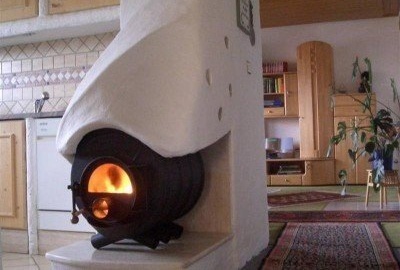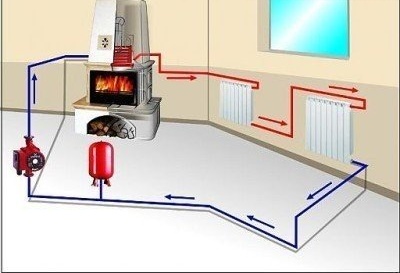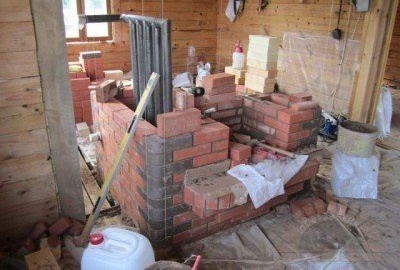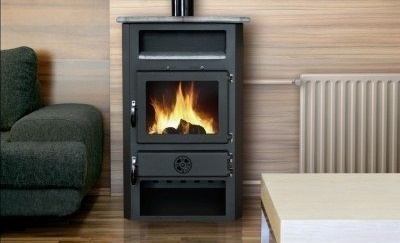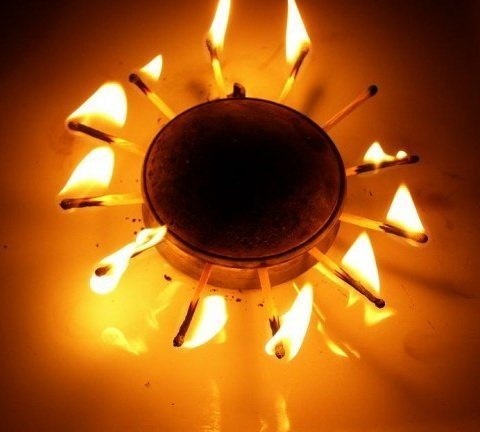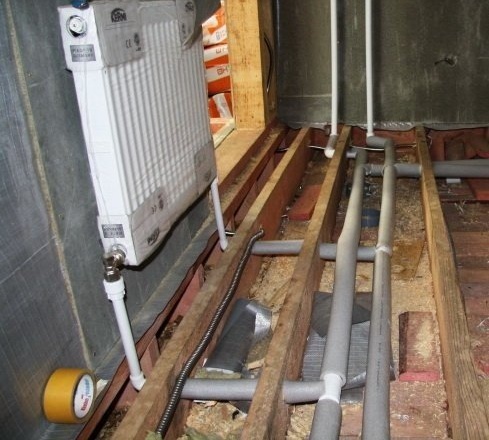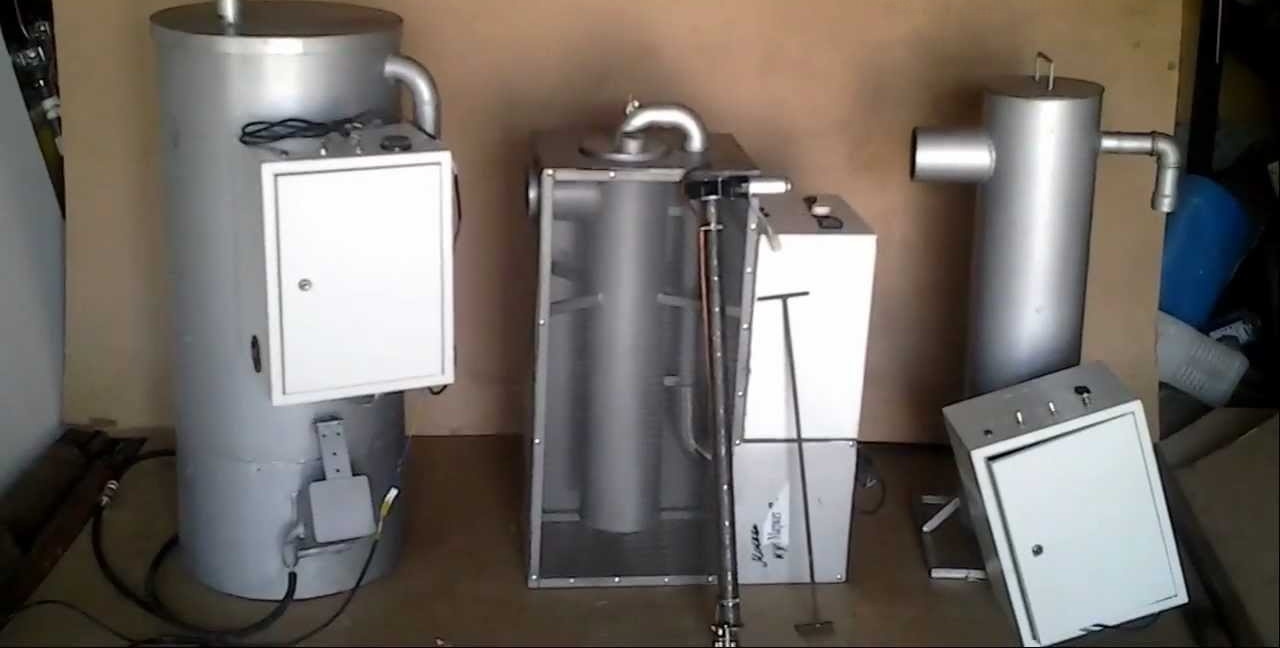Water heating stove for a private house - general
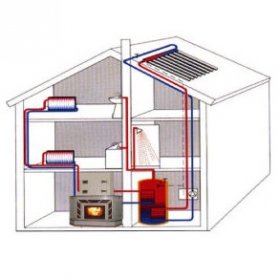
A man loves comfort, whose most important component is heat. Only a warm house will be truly cozy and comfortable for living. There are many ways to make it that way, and over time it only gets bigger. However, one of the oldest, stove heating, is still not forgotten and is especially popular in various parts of the country.
Content
The device of a traditional furnace
The structural features of the device suggest its placement as close as possible, and ideally, in the center of the heated dwelling. The front of the stove was traditionally located in the kitchen and was used for cooking. The back wall heated the rest of the house.
The source of heat is the fire burning in the lower part of the structure and smoke rising through the boilers into the chimney. It is estimated that an average of 1 square. m of the furnace can warm about 35 square meters. m room. Given the total area of the house, it is not difficult to calculate the minimum size of the structure.

Traditionally, the stoves were laid out of brick on a special clay mortar, and they necessarily plastered the finished surface
Furnaces are usually laid out of red brick on a special clay mortar. The constituent elements present in each design:
- chimney flue;
- firebox;
- boilers;
- ash pan.
Advantages and disadvantages of heating the stove
From time immemorial, there were stoves in many dwellings and today stove heating in a private house is not uncommon, since it is often the only possible way to warm the room. The advantages of the system include:
- Cost-effective installation. The stove is put into place quickly enough, with its arrangement, no serious financial investments will be required. Often you can use local material for its installation.
- Simplicity and low cost of maintenance.
- The ability to combine the stove and fireplace, having a unique decor and heater at the same time.
- Creating a unique atmosphere in the house of special comfort, which is characteristic only for this type of heating.
- Relatively high efficiency. A well-formed stove can have a capacity of about 60%, which is quite comparable with the efficiency of a liquid fuel boiler.
The ability to regulate the combustion process, the conservation and use of heat. The return and supply of air is carried out using dampers, their location allows you to adjust the temperature in the house.
It is important for everyone who is going to equip the stove heating of a country house or any other building to know about the most significant shortcomings of the system, which include:
- Long heating of the furnace.Quite a lot of time will pass from the moment of ignition until the design begins to fully transfer heat.
- Significant loss of floor space. The device requires a lot of space, since the larger its dimensions, the longer it will give off heat.
- Uneven room heating: near the oven, the temperature is higher, near the walls - much lower.
- Non-compliance with sanitary requirements: significant pollution of the room in which the furnace is located.
- High fire hazard.
- If the equipment is improperly maintained, there is the possibility of carbon monoxide poisoning.
Furnace heating with coolant
A very successful variation of traditional stove heating is a system with a water circuit. It successfully combines the advantages of water and furnace heating, which allows it to evenly and rationally distribute heat throughout the room. Moreover, such a system is able to heat several rooms at the same time.
The device of the furnace with a water boiler
The furnace used in such a system works like a solid fuel boiler. However, unlike him, it heats up not only the coolant, but also its own walls and smoke channels, which also participate in the heating of the room. Thus, furnace heating with a water circuit provides heat transfer to the radiators only during the combustion process. However, the heated surface of the furnace emits heat until it cools completely.
Register: destination and device
The main structural difference of a heating furnace with a heat carrier is the presence of a so-called register or heat exchanger or coil. This is the name of the part installed in the firebox, through which the coolant circulates. The traditional water heating system is connected to it.
The design of the part can be the most diverse, the main thing is that it ensures the maximum of all possible temperatures of the coolant located in it and does not interfere with its constant and uniform circulation.
For the manufacture of the register, sheet steel with a thickness of 3 to 5 mm or metal pipes is used. Very popular are sheet steel heat exchangers, which are fairly easy to process. In addition, such products are relatively easy to clean from combustion products. The main disadvantage is the small heating area, which distinguishes them disadvantageously from registers made of metal pipes. Most often, coils are made to order, for a specific model and size of the furnace. In some cases, they can even be done on their own.
Design and installation details
Furnace heating is a potentially dangerous system, so special attention should be paid to its design and proper installation.
What to look for when designing a project?
Typically, a stove heating scheme is developed simultaneously with the construction project, since it is closely related to the layout of the premises. The location of the furnaces should, wherever possible, be in the area of the internal walls. Access to the furnace should not be difficult, and it’s best if you can access it from the corridor.
Particular attention should be paid to the fire safety of the system. Since a frequent cause of fire is excessive heating of the wooden parts, an air gap or backing must be left between the stove and the wooden partitions. Also, the surface of a combustible structure can be faced with brick or equipped with so-called butchering - insulating structures made of fire-resistant materials.
Preparation for installation of the furnace begins with strengthening and thermal insulation of the floor area on which it will be installed.When arranging a furnace weighing more than 750 kg, a special foundation is necessarily mounted for it. It should be borne in mind that the design differs from the traditional foundation for the house, from which a gap of 50 mm wide filled with sand should separate it.
The furnace model is selected taking into account the size and configuration of the room in which it will be installed. Brick layout options can be found in special guides or on the Internet. The part of the system, which is water heating, is designed in the same way as any traditional water design.
Mounting Features
As practice shows, a water heating furnace can be installed in two ways:
- Design and fold to a specific register.
- Install the heat exchanger in an existing furnace.
The most time-consuming and difficult is the second option. It involves the dismantling of the existing structure, the installation of a carefully sized register and re-installation of the structure. The process may be complicated by the need to replace old items.
In any case, the thickness of the so-called “water jacket” should not be less than 4 cm, otherwise the water may begin to boil. This rule is especially relevant for systems with natural circulation; when the pump is installed, the risk of boiling is reduced.
Building a country house with stove heating is quite simple. Properly designed and installed equipment guarantees a long and flawless operation. Especially successful is stove heating with a coolant, which everywhere displaces the traditional stove. Such a practical, economical and effective solution will provide warmth and comfort in your home.
